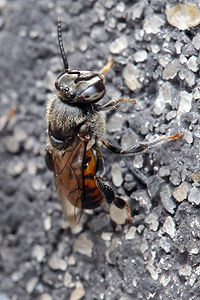
Photo from wikipedia
Abstract The potent role of endogenous melatonin (MEL) in affecting chilling injury (CI) and related chilling tolerance regulatory mechanisms in harvested litchi fruit during refrigeration at 4 °C were investigated… Click to show full abstract
Abstract The potent role of endogenous melatonin (MEL) in affecting chilling injury (CI) and related chilling tolerance regulatory mechanisms in harvested litchi fruit during refrigeration at 4 °C were investigated in this study. In the first experiment, exogenous MEL exposure exerted an inhibitory impact on the development of CI severity in refrigerated litchi fruit, as indicated by the lower CI index and delayed red color loss of pericarp, whereas treatment with p-chlorophenylalanine (p-CPA), an inhibitor of MEL biosynthesis, aggravated the degree of CI. The suppression of CI afforded by exogenous MEL was abated under the combined application of exogenous MEL and p-CPA. In the second experiment, the effects of p-CPA alone treatment on changes in biochemical parameters during refrigeration were analyzed. The results showed that p-CPA down-regulated the expressions of MEL biosynthesis genes, including LcTDC, LcT5H and LcSNAT, contributing to reduced generation of endogenous serotonin and MEL. p-CPA treatment accelerated oxidative stress-triggered membrane deterioration, as reflected by increases in relative leakage rate (RLR), reactive oxygen species (ROS) production, lipoxygenase (LOX) activity and malondialdehyde (MDA) accumulation. The membrane damage caused by p-CPA further resulted in loss of subcellular compartmentalization and enzymatic oxidation, as demonstrated by increased activities of polyphenol oxidase (PPO) and peroxidase (POD) in parallel with reduced contents of total phenolics and anthocyanin. Compared with control fruit, lower activities of antioxidant enzymes, including superoxide dismutase (SOD), catalase (CAT), ascorbate peroxidase (APX), monodehydroascorbate reductase (MDHAR), dehydroascorbate reductase (DHAR) and glutathione reductase (GR), were observed in fruit receiving p-CPA. Additionally, p-CPA suppressed the expression levels of genes encoding oxidized protein repair-related enzymes, including LcMsrA1, LcMsrA2, LcMsrB1 and LcMsB2. These results suggest that endogenous MEL might confer a protective role against chilling stress by modulating cellular redox status in harvested litchi fruit during refrigeration.
Journal Title: Postharvest Biology and Technology
Year Published: 2021
Link to full text (if available)
Share on Social Media: Sign Up to like & get
recommendations!